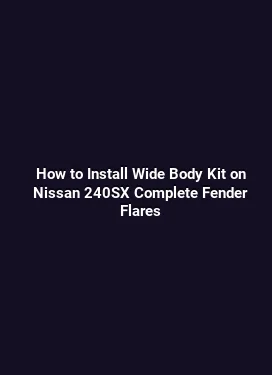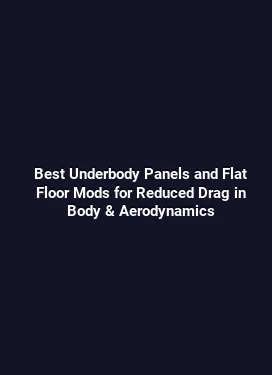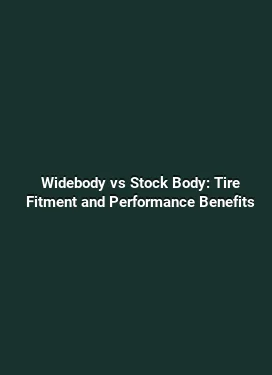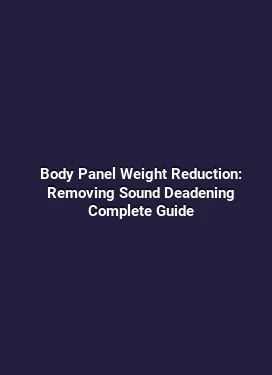Carbon Fiber Hood vs Fiberglass Hood: Weight Savings and Cost
Automotive body components like hoods play a pivotal role in weight distribution, aerodynamics, and overall performance. In performance-minded builds, the choice between carbon fiber and fiberglass is more than a cosmetic decision; it affects handling, thermal management, and even driving feel. This article delves into the practical implications of selecting a carbon fiber hood or a fiberglass alternative, focusing on weight savings, cost considerations, and real-world impact on aerodynamics and stiffness. Along the way, it explores trend vocabulary and latent semantic indexing concepts in a natural, reader-friendly way to help enthusiasts make informed decisions.
Weight Savings: Carbon Fiber Hood vs Fiberglass Hood

The primary draw for carbon fiber in automotive applications is its exceptional strength-to-weight ratio. Carbon fiber reinforced polymer (CFRP) hoods often weigh significantly less than their fiberglass counterparts, which translates into lower unsprung weight, improved suspension response, and quicker throttle response due to reduced rotational inertia. On average, a carbon fiber hood can shave 4 to 10 pounds from a vehicle’s front-end compared with a fiberglass hood, and in some high-end applications the savings may exceed 15 pounds. While those numbers vary by brand, construction method, and thickness, the practical impact on a tracked or spirited street car is measurable over time, especially during repeated cornering and braking cycles where weight reduction compounds the benefits of improved weight distribution.
Fiberglass hoods tend to be heavier than carbon fiber but still lighter than steel alternatives. A typical fiberglass hood might weigh in the range of 10 to 16 pounds, depending on thickness, resin system, and reinforcement strategy. While the difference between carbon fiber and fiberglass may seem modest in plain kilograms, the real-world effects accumulate in track days, autocross events, and even daily driving. A lighter hood reduces the load on the cooling system, can improve weight transfer during acceleration, and subtly affects steering feel as the front axle carries less inertia during abrupt maneuvers.
Material Properties and Real-World Impact

Carbon fiber is known for high specific strength and stiffness, meaning it resists bending and flexing under load while remaining lightweight. This translates into reduced hood deflection under high-speed wind pressure and during aggressive driving. On the other hand, fiberglass is more forgiving in terms of impact resistance and can tolerate minor impacts with less risk of shattering compared to brittle composites. This difference matters in everyday driving where road debris or minor impacts could affect panel integrity. The trade-off between rigidity and resilience is a practical consideration; some builders opt for hybrid approaches or alternative composite layups to balance stiffness with impact tolerance.
From a thermal perspective, the hood’s material affects heat management. Carbon fiber cores often incorporate aluminum or composite panels with specialized cores to manage heat, including challenges related to heat buildup in high-output engines. Fiberglass, when paired with appropriate core materials and insulating layers, can offer robust thermal performance at a lower price point, though it may require more careful engineering to match the stiffness-to-weight ratio of CFRP solutions. In terms of aerodynamic implications, the weight differential at the front of the vehicle subtly influences downforce distribution and lift characteristics at higher speeds; a lighter hood minimizes inertia, contributing to a more predictable front-end response as air flows over the fenders and windshield.
Practical Guidelines for Weight-Centric Builds
For performance-oriented builds, a practical approach is to quantify weight savings in relation to overall vehicle weight and desired handling targets. For example, in a compact sports car with a curb weight around 3,000 pounds, shaving 10 pounds from the front end represents roughly a 0.3% reduction in unsprung weight. While that percentage may appear small, the cumulative effect on steering response, braking stability, and corner entry can be meaningful over the course of a track session. When evaluating options, it’s essential to compare raw weight, weight distribution changes, and how the panel’s construction interacts with hood venting, heat management, and front-end aerodynamics. Lightweight options should be assessed alongside other weight-reduction strategies, such as polycarbonate headlights, lighter cooling components, or battery relocation in electrified or hybrid models.
Aerodynamics and Stiffness
Aerodynamics play a central role in how a car cuts through air, manages lift, and maintains front-end stability at speed. The hood is a critical surface that interacts with the windshield, cowl, and upper grille to shape the boundary layer, influence under-hood air pressure, and support hood venting strategies. Carbon fiber hoods, with their precise manufacturing tolerances and potential for optimized vent placements, can offer subtle aerodynamic advantages when paired with carefully designed vents or scoops. The ability to tailor geometry, vent size, and vent location enables engineers to direct hot air away from the engine bay and reduce under-hood pressure buildup. Fiberglass hoods, while capable of good aerodynamics, often arrive with standard or less optimized vent configurations. In performance-oriented builds, plenum-inspired ducting and venting arrangements are commonly integrated with CFRP hoods to maximize cooling efficiency and downforce management.
Stiffness is closely linked to how a hood maintains its shape under aerodynamic load and engine torque. CFRP typically provides superior stiffness, which helps maintain consistent gap tolerances with fenders and headlights and reduces hood flutter at high speeds. This rigidity helps maintain predictable hood alignment during high-G cornering and can contribute to consistent air separation at the hood line, improving front-end stability. Fiberglass hood designs, while robust, may experience slight flex under sustained high-load conditions, potentially altering the effectiveness of venting or the hood-to-cowl gap lockup. For performance enthusiasts, the decision often hinges on whether the minor gain in stiffness and aero predictability justifies the higher cost of CFRP.
Ventilation, Vent Placement, and Thermal Management
Vent placement is a nuanced aspect of hood design. Carbon fiber hoods frequently offer more options for vent integration because of the material’s stiffness and moldability. A well-placed vent can reduce under-hood temperatures, improve intake air temperatures for turbocharged or supercharged engines, and lower the risk of heat soak. When mounting vents, manufacturers consider the effect on laminar flow, potential heat recapture, and the risk of compressing airflow at the radiator core. Fiberglass hoods can support venting as well, but the available product ecosystem might be more limited in terms of vent geometry and finish compatibility. In practice, the choice of hood often leads to a coordinated approach to cooling strategy, with aggressive venting on CFRP hoods and more conservative, often factory-inspired venting on fiberglass options.
Cost Considerations and Lifetime Value
Cost is a defining factor for most builders, and the price gap between carbon fiber and fiberglass hoods reflects material costs, manufacturing complexity, and durability expectations. CFRP hoods typically carry a premium due to raw material costs, labor-intensive layups, and the need for precise finishing and resin management. A carbon fiber hood from a reputable maker can be several times more expensive than a fiberglass hood, with prices ranging from a few hundred dollars to well over a thousand, depending on brand, weave quality, and whether the hood includes vents or other functional features. For many enthusiasts, the price delta is weighed against the potential fuel economy benefits from weight savings, the improved handling dynamics, and the perceived prestige of CFRP components.
Fiberglass, while more affordable upfront, may incur higher long-term maintenance costs in some scenarios. Repairs in case of minor impacts can be straightforward with fiberglass, but cosmetic or structural repairs might require more labor to restore surface finish and paint fidelity. Carbon fiber panels, when damaged, often involve more specialized repairs or panel replacement, which can influence ownership costs over the vehicle’s lifetime. It’s important to factor in the availability of replacement parts, paint match, warranty terms, and the vendor’s support network when estimating lifetime value. For many drivers, the decision comes down to a balance between upfront investment and anticipated usage, whether the car is a weekend enthusiast vehicle, a track-focused machine, or a daily driver with sport-tuned aspirations.
Durability, Repairs, and Resale Considerations
Durability is a pragmatic dimension of the cost equation. Fiberglass is generally more forgiving of minor impacts and can be repaired with conventional techniques, which keeps ownership costs predictable in the event of curb contact or parking lot mishaps. Carbon fiber, while exceptionally strong in terms of stiffness-to-weight, can be more sensitive to sharp impacts and may require specialist repair services to preserve structural integrity. From a resale perspective, the presence of CFRP panels can be a differentiating factor for some buyers, signaling a performance-oriented build. Others may prioritize ease of repair and maintenance access, in which case fiberglass could be more appealing. The key is transparency in the build documentation and a clear understanding of what each hood provides in terms of weight savings, venting, and fitment quality.
Installation, Fitment, and Practical Considerations
Installing a new hood is more than a bolt-on task; it requires careful alignment, hood latch adjustments, and sometimes reconfiguring hood-to-cowl gaps. Carbon fiber hoods are highly dimensionally stable, which can simplify fitment and reduce the risk of gaps opening or closing with heat cycling. However, CFRP panels often demand precise surface preparation, high-quality primer and paint, and careful adherence to manufacturer torque specs for hood hinge bolts to preserve alignment over time. Fiberglass hoods may exhibit slightly more flexible behavior during initial installation, which makes shimming and alignment checks important to achieve consistent panel gaps and latch engagement. Regardless of material, professional installation, proper alignment checks, and verification of latch performance are essential for long-term reliability and road safety.
Edge finish and paint process play a significant role in fitment and aesthetics. Carbon fiber surfaces often require meticulous finishing to protect the resin and prevent micro-cracking under UV exposure. A high-quality clearcoat not only enhances appearance but also improves resistance to environmental factors such as road salt and temperature fluctuations. Fiberglass surfaces may be more forgiving during the finishing process, but the final paint match and surface smoothness remain critical for a seamless appearance. In both cases, preparation for paint—sanding, masking, and applying a compatible primer—greatly affects the final outcome. A well-executed paint job preserves the hood’s value and contributes to a consistent, factory-like look that stands up to scrutiny on the street or at the track.
Maintenance and Longevity
Maintenance practices differ subtly between carbon fiber and fiberglass. Carbon fiber panels typically benefit from regular cleaning with non-abrasive, resin-safe cleaners. It is prudent to inspect for microcracks or resin-rich areas that could indicate underlying issues, especially around mounting points and vent cutouts. Fiberglass hoods require checks for gelcoat integrity and potential moisture ingress in case of chip damage. Sealing exposed edges and ensuring proper vent seals can help maintain performance and prevent delamination. For daily drivers, protective films or clear bras can extend the hood’s life by shielding the surface from stone chips and environmental wear. In race-oriented scenarios, the emphasis shifts toward maintaining aerodynamic integrity, manageability under heat load, and ensuring that any protective coatings remain intact to preserve surface quality and paint adhesion over time.
Choosing Based on Vehicle and Driving Style
The decision between a carbon fiber hood and a fiberglass hood is rarely about a single metric. It is a holistic assessment that includes weight reduction goals, corrosion and impact considerations, maintenance philosophy, and the vehicle’s intended use. A track-focused build may justify the investment in a CFRP hood to maximize front-end responsiveness and cooling efficiency, especially when paired with optimized venting strategies and a compatible cooling system. On the other hand, a daily driver or a budget-conscious project may find fiberglass hoods to be a more sensible choice, delivering noticeable weight reduction without the premium price tag and with easier repairs should cosmetic damage occur. The broader context of weight distribution, stiffness, and aerodynamic behavior should be incorporated into the overall tuning strategy, recognizing that the hood is one element of a complex ecosystem that includes suspension tuning, brake balance, aero components, and engine cooling configuration.
In practice, an objective evaluation of both options includes real-world testing and measurements: sticking with OEM tolerances where possible, using a scale to verify exact weight differences, and performing aero checks with wind tunnel data or CFD insights when available. For enthusiasts who track cars extensively, recording lap times, stability indicators, and braking performance before and after the hood swap provides concrete data to inform future modifications. LSI-informed content strategies in the automotive domain emphasize these aspects by connecting surface-level descriptions with underlying functional implications, such as how weight distribution translates to cornering behavior and how stiffening the hood influences throttle response under load. This approach helps readers understand not just what changes, but how those changes manifest during spirited driving.
Ultimately, the choice should align with the vehicle’s mission and the owner’s priorities. If you value ultimate rigidity, optimized venting, and the prestige of CFRP construction, a carbon fiber hood can be a compelling upgrade. If you seek a cost-effective path to weight reduction with straightforward maintenance and repair, fiberglass offers a robust alternative. Regardless of selection, the integration with other performance components—cooling, aero, and chassis tuning—will determine the extent to which front-end behavior improves, remains neutral, or requires compensatory adjustments elsewhere in the vehicle’s setup.






